|
Pusanweb
Subway Guide
|
Overview
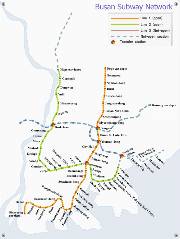 |
The are two main subway lines in Busan, Line 1 and Line 2.
Upon completion of the second line, the subway will stop at over 100 stations
all over the city and the surrounding area. The intersection point of
the two lines is Seomyeon Station, 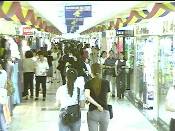 which
is Stop 19 of line 1. The areas around Seomyeon and Nampodong Stations
are home to underground shopping malls featuring hundreds of small shops
selling a variety of electronics, clothing, sporting goods and an eclectic
mix of other goods.
which
is Stop 19 of line 1. The areas around Seomyeon and Nampodong Stations
are home to underground shopping malls featuring hundreds of small shops
selling a variety of electronics, clothing, sporting goods and an eclectic
mix of other goods.
Line 1 travels North-South. It starts in the north at Nopodong and travels 39 stops until it reaches Shinpyong at the southern edge of the city. Construction of this subway line was completed in 1995.
Line 2 will, upon completion, extend from the city of Yangsan, north of Pusan, all the way to the beach-side resort of Haeundae. Line 2 starts at the intersection point between the two lines in Seomyeon and heads west 6 stops to Churye, where it vears north and follows the river Han until it reaches Hop'o. A new extension will be completed on the north end of Line 2, from Hop'o to Yangsan, including some 22 extra stops by mid-2002. Extension of Line 2 that heads in an easterly direction toward Haeundae has developed as a two-phase project. The first part, from Hop'o through Seomyeon, proceeding east to Kwanganli, opened in 2001 and the second section which will continue the line east until it reaches Haeundae, is scheduled to be completed by the end of 2002.
Tickets and hanaro cards
When
using the subway there are two options available to pay for your travel
along the lines.
The first is to invest in a Hanaro card.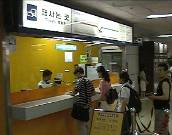 The card costs 2000 won, and can credited with
amounts of up to 10000 won at a time. The card has three advantages
over the regular ticket. 1) You don't have to go through the tiresome
exercise of finding your change and waiting in line to purchase a ticket
every time you use the subway. 2) It's about 10% cheaper. 3) You don't
have to make adjustments for the length of your travel. The Hanaro card is
also valid on buses and will eventually be so for taxis and other
services. It is easy to purchase one of these cards yourself. Simply
approach the glass windowed office in any subway station and ask for
a Hah Nah Roh Cah-duh.
The card costs 2000 won, and can credited with
amounts of up to 10000 won at a time. The card has three advantages
over the regular ticket. 1) You don't have to go through the tiresome
exercise of finding your change and waiting in line to purchase a ticket
every time you use the subway. 2) It's about 10% cheaper. 3) You don't
have to make adjustments for the length of your travel. The Hanaro card is
also valid on buses and will eventually be so for taxis and other
services. It is easy to purchase one of these cards yourself. Simply
approach the glass windowed office in any subway station and ask for
a Hah Nah Roh Cah-duh. 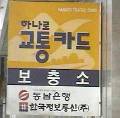 As with all
other requests of this kind, make as many positive hand gestures as
possible. It is also useful to give the attendant the exact change of
12000 won, to make it even more clear of your intentions. To add
credit to your card, simply give the attendant your card and at least
10000 won to add. Cards can also be purchased and credit purchased
at any store posting an Hanaro sign outside. Many convenience stores
(like Family Mart and LG25) and other assorted shops offer this service.
As with all
other requests of this kind, make as many positive hand gestures as
possible. It is also useful to give the attendant the exact change of
12000 won, to make it even more clear of your intentions. To add
credit to your card, simply give the attendant your card and at least
10000 won to add. Cards can also be purchased and credit purchased
at any store posting an Hanaro sign outside. Many convenience stores
(like Family Mart and LG25) and other assorted shops offer this service.
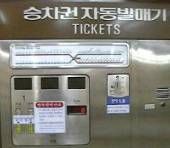 The
easiest way to purchase a ticket to use the subway is to approach the
attendant in the fishbowl style office that has been placed inside each
subway center. Simply tell the attendant your subway destination and give
him either 500 won for a sub-ten stop trip, and 600 for a longer
trip.
The
easiest way to purchase a ticket to use the subway is to approach the
attendant in the fishbowl style office that has been placed inside each
subway center. Simply tell the attendant your subway destination and give
him either 500 won for a sub-ten stop trip, and 600 for a longer
trip. 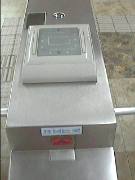 In order to purchase a ticket you approach the large square
tin cans that appear all over the subway. You can also
purchase tickets from automatic vending machines. There are columns
for single and round trips. The top rows of numbers refer to the
number of passengers, the second rows to the length of the trip.
Press the appropriate numbers and the tickets should automatically be
dispensed. The ticket is inserted and returned at the entrance
booth, inserted and kept upon exiting. Hanaro cards can be kept in a
wallet and waved over the scanner atop the entrance/exit stalls.
In order to purchase a ticket you approach the large square
tin cans that appear all over the subway. You can also
purchase tickets from automatic vending machines. There are columns
for single and round trips. The top rows of numbers refer to the
number of passengers, the second rows to the length of the trip.
Press the appropriate numbers and the tickets should automatically be
dispensed. The ticket is inserted and returned at the entrance
booth, inserted and kept upon exiting. Hanaro cards can be kept in a
wallet and waved over the scanner atop the entrance/exit stalls.
Etiquette
The general rules of etiquette are
fairly straightforward. 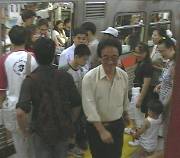 When entering a subway car passengers generally enter
from either side of the door. This allows passengers exiting the door to
walk out through the middle of the door in a straight line. There is often
a great deal of feet stepped on, stomachs gouged by elbows and many other
things not normally found in lines in the west. This sort of posturing is
not personal. In fact, I doubt that the passengers are even consciously
aware that they're pushing someone. Stay calm, push back at the same level
of strength and remember, it's only a subway.
When entering a subway car passengers generally enter
from either side of the door. This allows passengers exiting the door to
walk out through the middle of the door in a straight line. There is often
a great deal of feet stepped on, stomachs gouged by elbows and many other
things not normally found in lines in the west. This sort of posturing is
not personal. In fact, I doubt that the passengers are even consciously
aware that they're pushing someone. Stay calm, push back at the same level
of strength and remember, it's only a subway.
If a passenger who is 55+ enters the subway the youngest Korean over, say, 13 years old is expected to stand up and give their seat to their elder. If a foreigner does this, surprise and respect generally ensue.
As with all things of this sort, these are general guidelines, not followed by everyone, and not legally binding.
Updated April 2002
For more information, visit http://www.subway.busan.kr/english/